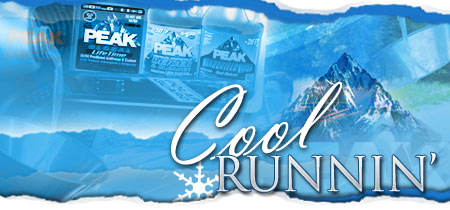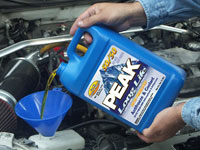
Changing Coolant & Antifreeze Keeps Cars Cool
Keep your car running cool in the summer and safely in the winter by changing the coolant and antifreeze, and using new products formulated for longer life and better automotive "hydration."
 |
Topping-off your coolant system with a compatible antifreeze, such as PEAK® Long Life, can help prevent costly and potentially dangerous engine failure. |
TV ads for sports beverages that are formulated to keep your body properly hydrated, while restoring vitamins and minerals that you need to perform properly under hot and demanding conditions, should serve as a reminder that your car is much like the body of a world-class athlete. When sufficiently fueled and fortified with the proper fluids; your car, truck or SUV should get you from the starting block to the finish line…without working up a sweat or stopping for a breather along the way.
The next time you are cooling off with a sports drink after running or working out, take a few minutes to make sure your car's engine is also properly hydrated. (Caution: Attempting to remove radiator cap when system is hot can result in severe burns and other injury. Allow sufficient time for engine to cool after driving.)
How to Check Coolant and Antifreeze
1. Pop the hood
2. Find the coolant reservoir (usually a white, semi-clear plastic receptacle with black cap) and look to see if the coolant level is at or near the FULL COOL indicator line.
3. If the vehicle's coolant system level is low, add a 50-50 mixture of antifreeze/coolant and clean water.
These three steps can save you hundreds and even thousands of dollars in engine repairs, along with helping to ensure that you and your passengers are not stranded in cold and unsafe conditions.
Global Antifreeze/Coolant Ends Confusion
To make it even easier to maintain your car's cooling system, leading manufacturers have introduced advanced global formula products that can be used in any automobile, regardless of make, model, year or original antifreeze color – including GM DEX-COOL ® and new Ford and Chrysler coolants.
Designed with a phosphate-free and silicate-free formula that is compatible with domestic, Asian and European OEM specifications, PEAK® Long Life provides 150,000 miles or 5 years of maximum protection when a cooling system flush and fill is performed.
Available fully formulated, for complete flush and fill applications, or a 50/50 pre-diluted formula, PEAK features an amber color that will not change the current antifreeze color when used for topping off.
“Instead of hesitating or spending time trying to sort out the confusing color codes that carmakers have come up with, consumers can now use a single extended life antifreeze/coolant with total confidence that it will perform well and keep their warranty intact,” said Sperling, of PEAK ® Performance Products, makers of PEAK ® Long Life Coolant/Antifreeze.
To Flush & Fill…or Top-Off
If you changed your antifreeze recently, but your system level is low, this may be an indication that you have a leaky hose or loose radiator hose clamp. Any hoses that show signs of wear, leakage, cracking or rotting should be replaced. After making necessary repairs, use an antifreeze ball tester (available at any auto parts store) to make sure that the antifreeze-to-water ratio is correct. Then, top-off with a “ready to use” mixture of antifreeze/water such as PEAK ® Long Life 50/50 Pre-Diluted Antifreeze & Coolant.
If your coolant system level is drastically low or the glycol-to-water ratio is not correct, you might consider flushing the system and then filling it with a fresh antifreeze and water mixture to bring it back within operating specifications.
“Flushing and filling a car's cooling system with a fresh mixture of antifreeze and water is easier than most people think, and it's one of the smartest things vehicle owners can do to protect their investment and help ensure uninterrupted performance,” said Sperling.
The Flush and Fill process takes 10 Easy Steps:S
teps:
Step 1: Clean the radiator
Step 2: Place a drain pan
Step 3: Remove the radiator pressure cap
Step 4: Inspect the pressure cap & hoses
Step 5: Drain the radiator
Step 6: Rinse the radiator
Step 7: Add the coolant and water mixture
Step 8: Bleed the system
Step 9: Replace the pressure cap
Step 10: Clean up
For details about these steps and the importance of maintaining your vehicle's cooling system or to learn more about the advanced technology that goes into universal antifreeze/coolants such as PEAK Long Life, visit PEAK Antifreeze.
Source: PEAK Antifreeze |